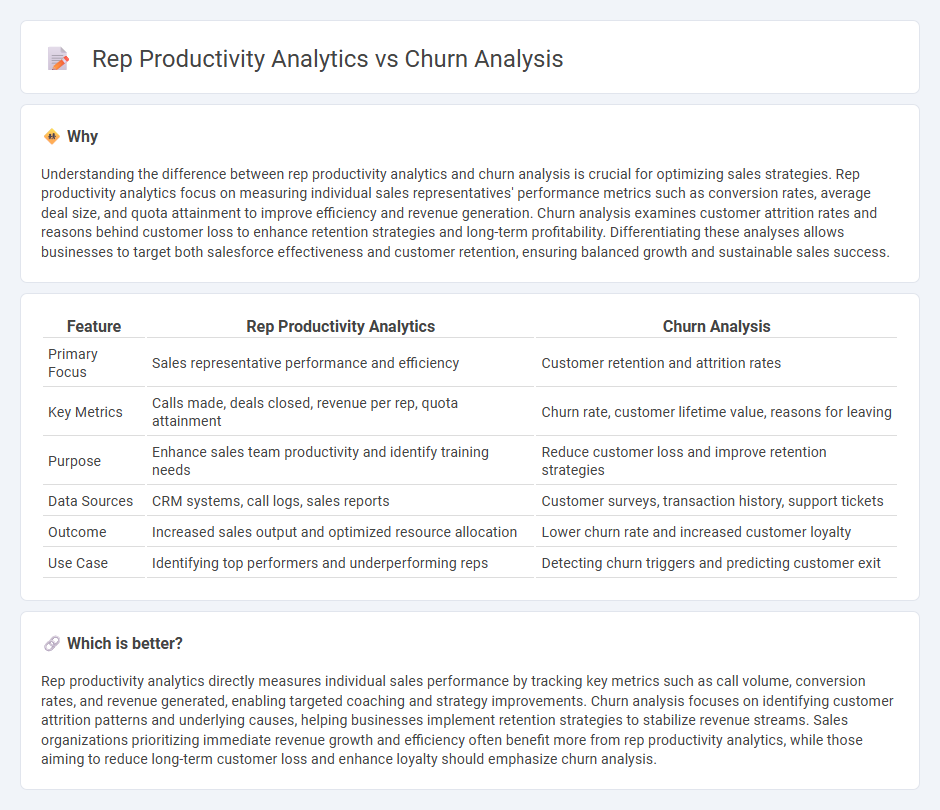
Sales rep productivity analytics focuses on measuring individual performance through metrics such as conversion rates, average deal size, and time to close, enabling targeted coaching and resource allocation. Churn analysis examines customer attrition patterns by identifying factors like contract length, satisfaction scores, and purchase frequency to reduce revenue loss and improve retention strategies. Explore further to understand how combining these insights drives sustainable sales growth.
Why it is important
Understanding the difference between rep productivity analytics and churn analysis is crucial for optimizing sales strategies. Rep productivity analytics focus on measuring individual sales representatives' performance metrics such as conversion rates, average deal size, and quota attainment to improve efficiency and revenue generation. Churn analysis examines customer attrition rates and reasons behind customer loss to enhance retention strategies and long-term profitability. Differentiating these analyses allows businesses to target both salesforce effectiveness and customer retention, ensuring balanced growth and sustainable sales success.
Comparison Table
| Feature | Rep Productivity Analytics | Churn Analysis |
|---|---|---|
| Primary Focus | Sales representative performance and efficiency | Customer retention and attrition rates |
| Key Metrics | Calls made, deals closed, revenue per rep, quota attainment | Churn rate, customer lifetime value, reasons for leaving |
| Purpose | Enhance sales team productivity and identify training needs | Reduce customer loss and improve retention strategies |
| Data Sources | CRM systems, call logs, sales reports | Customer surveys, transaction history, support tickets |
| Outcome | Increased sales output and optimized resource allocation | Lower churn rate and increased customer loyalty |
| Use Case | Identifying top performers and underperforming reps | Detecting churn triggers and predicting customer exit |
Which is better?
Rep productivity analytics directly measures individual sales performance by tracking key metrics such as call volume, conversion rates, and revenue generated, enabling targeted coaching and strategy improvements. Churn analysis focuses on identifying customer attrition patterns and underlying causes, helping businesses implement retention strategies to stabilize revenue streams. Sales organizations prioritizing immediate revenue growth and efficiency often benefit more from rep productivity analytics, while those aiming to reduce long-term customer loss and enhance loyalty should emphasize churn analysis.
Connection
Sales rep productivity analytics identifies performance patterns and key drivers influencing individual and team outcomes, while churn analysis highlights customer attrition trends impacting revenue stability. Integrating both analytics enables sales leaders to correlate rep effectiveness with customer retention rates, uncovering behaviors that reduce churn and boost lifetime value. Optimizing rep activities based on churn data supports targeted coaching, improves sales strategies, and enhances overall revenue growth.
Key Terms
**Churn Analysis:**
Churn analysis identifies patterns and reasons why customers discontinue services, using metrics like churn rate, customer lifetime value (CLV), and retention rates to forecast future attrition trends. It employs predictive modeling, customer segmentation, and behavior analysis to improve retention strategies and enhance customer satisfaction. Explore deeper insights into churn analysis methodologies and tools to optimize customer loyalty.
Retention Rate
Churn analysis identifies customer attrition patterns to improve retention rate by targeting at-risk segments and enhancing satisfaction through personalized interventions. Rep productivity analytics measures sales team efficiency and performance impact on retention by tracking key activities like follow-ups, communication frequency, and conversion rates. Explore deeper insights on how these analytics drive retention strategies and boost customer lifetime value.
Customer Lifetime Value (CLV)
Churn analysis identifies patterns and risk factors contributing to customer attrition, enabling strategies that enhance retention and maximize Customer Lifetime Value (CLV). Rep productivity analytics assesses sales representatives' performance metrics such as conversion rates, average deal size, and customer interactions to improve efficiency and drive revenue growth linked to higher CLV. Explore more to understand how integrating these approaches can optimize overall business profitability and customer engagement.
Source and External Links
How to Conduct Churn Analysis: A Complete Guide - CleverTap - Churn analysis involves assessing customer behavior to understand why customers leave and how to improve retention, with key steps including data collection, calculating churn rate, and customer segmentation to tailor retention strategies.
How to Do a Churn Analysis: 3 Quick & Easy Steps [2023 Update] - Churn analysis calculates churn rate by dividing lost customers by total customers, and uses KPIs like engagement, support tickets, and competitor pricing to gain actionable insights for reducing customer loss.
Customer Churn Analysis: How to Identify and Reduce Churn - Conducting churn analysis involves defining churn rate, identifying churned customers, and analyzing behavior and feedback to develop improvement strategies, ideally using integrated data platforms.
 dowidth.com
dowidth.com